#agrivoltaics
Link
Sheep living among rows of solar panels spend more time grazing, benefit from more nutritious food, rest more and appear to experience less heat stress, compared with nearby sheep in empty fields.
Earlier research suggested that agrivoltaic farms – which combine grazing animals with solar panels – offer more efficient renewable energy at lower overhead costs, as well as reducing wildfire risks. The latest findings show that the practice is also good for animal welfare, providing further evidence for a win-win situation, says Emma Kampherbeek, who carried out the work while at Wageningen University in the Netherlands.
[...]
As for pasture quality, the nitrogen content was higher and carbon content lower in the solar panel fields, suggesting that the vegetation in this pasture – which was greener – was more nutritious and more easily digestible. That might be due to the reduced exposure to intense solar rays and to dew dripping off the panels, providing much-needed moisture, she says.
The results are likely to be even more pronounced in warmer seasons, she adds. Additional research is under way to analyse the data taken from temperature recordings during her study.
Sheep make good candidates for agrivoltaics because they are efficient foragers, keeping weeds off solar panels, and are small enough to pass under the panels, says Kampherbeek. And, unlike goats, they don’t chew the electrical wires.
The findings strongly suggest that solar power centres should be designed with a partner animal species in mind, she says.
9K notes
·
View notes
Photo

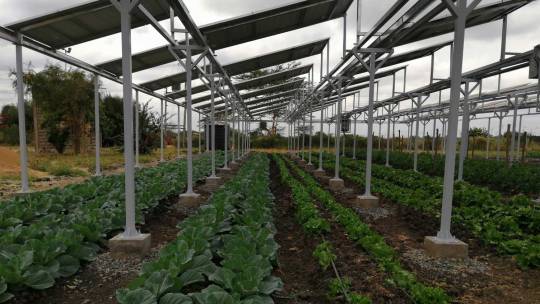
Innovative Project Is Growing Crops Beneath Solar Panels in Kenya
The project, officially called “Harvesting the sun twice,” is designed to assess whether or not agrivoltaic systems could be successfully used in rural East Africa.
By combining the land dedicated to solar panels with the land dedicated to agriculture, it is possible to avoid some of these pitfalls. Growing plants beneath elevated solar panels protects them from the sun in hot, dry places and helps the soil retain moisture, the University of Sheffield explained. The strategy has worked successfully in Global North countries like France, Germany and the U.S., but has not been tested in the Global South, according to SEI and The Guardian.So far, the results have been promising, The Guardian reported.
In Kajiado, cabbages cultivated under 180, 345-watt solar panels were a third larger and healthier than the control group. Eggplants, lettuce and corn also fared better in the panels’ shade.
1K notes
·
View notes
Text

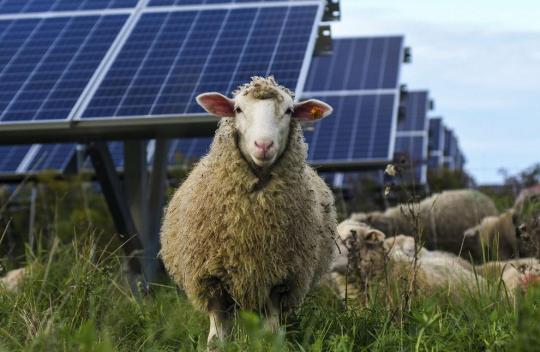




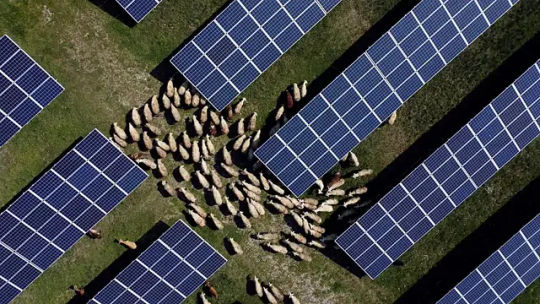

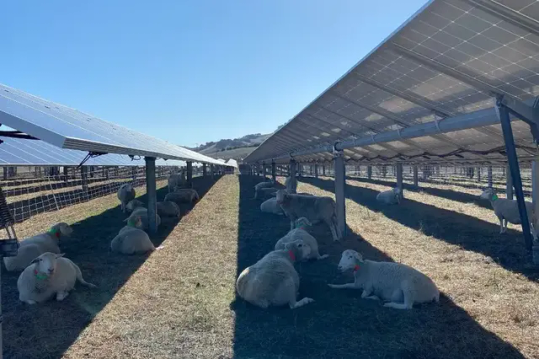
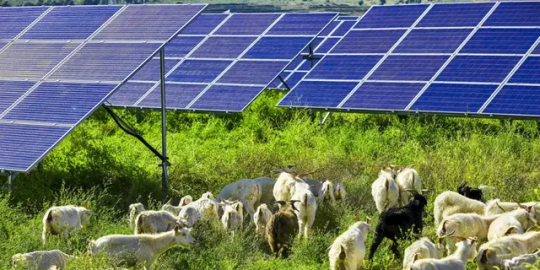

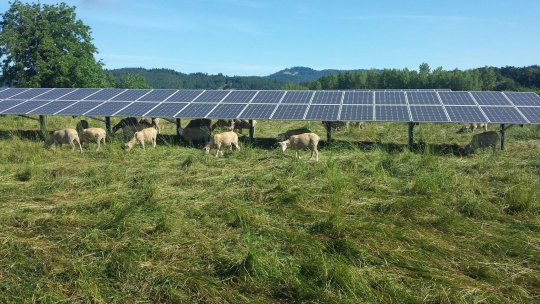
Sheep of a solar-farm flock together charmed
#solar farm#solar sheep#solar#sheep#environment#Solarpunk#inspiration#solar grazing#solar farming#solar farmer#agrivoltaics#agricola's#photovoltaic#sheepvoltaic#poem#climate#climate hope#vibe#solar vibe#aesthetic#solar flock
8 notes
·
View notes
Text


I would like u to know that no one has ever suffered as i have
2 notes
·
View notes
Link

Excerpt from this story from Inside Climate News:
Despite being “yucky” according to some picky eaters, broccoli is well-suited to grow alongside solar panels, according to a new study.
The research from Chonnam National University in South Korea is part of the growing field of “agrivoltaics,” in which agronomists and energy experts look for opportunities for solar power and agriculture to exist on the same land in an effort to meet the world’s needs for both energy and food.
The findings, published in the journal Agronomy, show that shade provided by solar panels helps to make broccoli a deeper shade of green, which makes the vegetable more appealing for grocery stores and consumers without a significant loss of the crop’s size or nutritional value.
But the greatest financial benefits for farmers come from producing energy. Income from solar was about 10 times the income from broccoli, which indicates that farmers already growing the vegetable are missing out on an opportunity by not having solar panels in the same fields, according to the study. The authors include Kang Mo-Ku, a horticulture professor.
The paper is “a great case study,” said Jordan Macknick, a lead analyst at the National Renewable Energy Laboratory in Colorado, whose work deals with agrivoltaics.
His main caveat is that the results only apply to one crop being grown in one region. He said the paper provides evidence that should encourage additional research in other places and with other crops.
He would know. His team at NREL has several projects involving solar alongside carrots, chard, kale, peppers and tomatoes, among others.
58 notes
·
View notes
Text
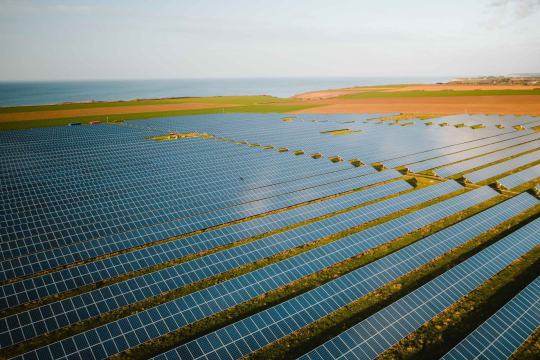
Agrivoltaics, agrivoltaics, agrivoltaics!
Article from Greentech Renewables here
Not only does the shade from the PV modules reduce water use for the crops, the presence of the crops cools the modules and increases energy generation.
The benefits (generically shown) of dual use on 2 hectares:
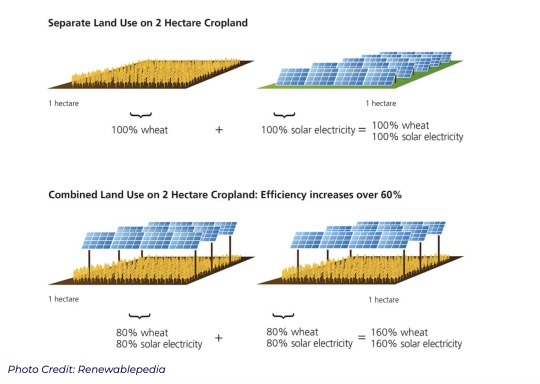
2 notes
·
View notes
Text
youtube
How Solar Panels Are Changing Agriculture - Agrivoltaics Revisited. Experiments in agrivoltaics (solar panels plus farming) have had some really promising results over the last year, like using new technology (luminescent solar concentrators) to double food production and implementing AI systems to better harvest sunlight … but is getting twice the use per acre really a win-win for sustainable farming and renewable energy? It takes a certain type of vegetable to thrive in these environments, and the upfront costs for this technology can be crippling. Can tech and AI really enter the food production industry and reshape it, like they’ve done for so many others?
Watch Cooling Our Homes Without Electricity? • Cooling Our Homes...
Also check out our first Agrivoltaics video; Solar Panels Plus Farming? Agrivoltaics Explained • Solar Panels Plus...
Video script and citations:
https://undecidedmf.com/how-solar-pan...
Some of the companies referenced in the video:
Insolight - https://insolight.ch/
GroenLeven - https://groenleven.nl/
UbiGro - https://ubigro.com/
Jack's Solar Garden - https://www.jackssolargarden.com/
Sun'Agri - https://sunagri.fr/en/
Get my achieve energy security with solar guide:
https://link.undecidedmf.com/solar-guide
Follow-up podcast:
Video version - / @stilltbd
Audio version - http://bit.ly/stilltbdfm
#Undecided with Matt Ferrell#solarpunk#Agrivoltaics#solar power#solar panels#solar energy#green energy#renewable energy#farming#agriculture#Insolight#GroenLeven#UbiGro#Jack's Solar Garden#Sun'Agri#Youtube
2 notes
·
View notes
Text
oooooooomygd
#YO??????#THIS IS SO COOL#energy#solar energy#agrivoltaics#putting my degree to good use. on tumblr#to the government agent reading this
1 note
·
View note
Text
Lightstar Renewables Unveils Landmark Agrivoltaics Solar Project
Key Insights:
Lightstar Renewables secures permits for the Nesler Road agrivoltaics community solar project, a pioneering endeavor in Illinois.
The project, covering 36 acres with a 4.95 MW AC capacity, aims to supply power to 1,100 homes yearly without compromising the land’s agricultural use.
It uniquely combines solar energy production with hay farming, supporting livestock nutrition during…

View On WordPress
0 notes
Text

Are you looking for a way to save money on your energy bills and reduce your carbon footprint? If so, you might be interested in this new solar panel concept that could reduce the payback time to just five years! 😮
According to NXTGEN Energy, a UK-based company that offers solar panel grants and installation services, this innovative approach, known as agrivoltaics or Agri-PV, involves the integration of solar farms with "shadow-friendly" crops. A team of experts from the esteemed University of Lisbon and the Military Academy in Portugal collaborated on this study, highlighting the immense potential of Agri-PV to expedite the global transition towards sustainable energy sources. 🌱
If you want to learn more about this new solar panel concept, check out this blog post by NXTGEN Energy, where they explain how it works and what benefits it can bring - New solar panel concept could reduce payback time to just five years. You can also find out more about the solar panel grants and incentives available in the UK, such as the Energy Company Obligation (ECO4) scheme, the Home Upgrade Grant (HUG2) scheme, and the Solar Together scheme. 🙌
Don’t miss this opportunity to go green with solar panels and join the renewable energy revolution. Contact NXTGEN Energy today and get a free quote for your solar panel installation. ☀️
0 notes
Text
#a grim and sunken vow#agribusiness#agricoltori#agricoltura#agrigento#agritech#agrivoltaics#dion agriche#gordon agrippa#marcus agrippa#Spotify
0 notes
Link
Recent research has begun to provide data on how well urban agriculture actually works if you’re planning to, you know, eat. A review paper published last month by researchers working on the Rurban Revolution project surveyed previous studies and determined that on average, urban agricultural yields (including both outdoor and indoor growing operations) were on par or higher than those of typical farms. But certain crops, like lettuces, tubers, and cucumbers, had yields up to four times higher when grown in cities. A separate team of scientists in Australia looked at 13 urban community farms for a year and found their yields to be twice that of typical commercial vegetable farms.
The caveat, though, is that this productivity comes in part from intensive human labor. On a commercial farm, crops are usually grown one at a time and tended with specialized equipment—you can’t plant wheat and carrots in the same field because they’re harvested in totally different ways. Crops also have to be spaced out to make room for where the equipment drives, reducing the amount of land that’s actually producing food.
An urban farm, by contrast, can grow all kinds of crops packed closely together because they’re harvested by hand. That’s part of the reason why Bousselot’s tiny rooftop garden in Denver is so productive. That crop diversity also means you can harvest different plants at different times—tomatoes in August, pumpkins in October—so the supply of food is more broadly distributed. Even though Bousselot has already harvested over 200 pounds of food, she still has two months left to go.
That requires human labor instead of a machine. So while urban farming can have a higher yield than traditional agriculture, it’s not necessarily as efficient. “But that inefficiency could easily change,” says Robert McDougall, an agricultural scientist at the independent research company Cesar Australia, who led the Australia study. “The people I studied were people who carried out urban farming mostly for recreational purposes, and so weren’t really interested in working as efficiently as possible. And they weren’t necessarily using the most efficient sources of materials.”
Take water, for example. Cities are currently designed to be impervious to rain, quickly draining it off streets to keep roads and buildings from flooding. But some urban areas are now transitioning into “sponge cities,” designed to safely soak up rain and store it for later use. In Los Angeles, for instance, officials are experimenting with roadside green spaces, where water seeps underground and into storage tanks. Rurbanized cities of the future could tap into that water source to grow food, and the gardens themselves could act like sponges, collecting rainwater to prevent local flooding.
Better municipal composting programs could also provide urban farmers with mulch so they don’t have to rely on synthetic fertilizers, which are terrible for the environment. “Were the gardeners I studied more tapped into these various sources of materials that were available within the environment around them,” says McDougall, “they could have easily carried out their farming in a much more sustainable fashion.”
Urban farms attract a host of pollinators like bees, McDougall has found. These insects, along with other pollinators like birds, could help boost biodiversity.
Cities also need all the green spaces they can get to counter the “urban heat island effect,” or the tendency for the built environment to absorb more of the sun’s energy than parks and forests do. Temperatures in urban areas can be 20 degrees Fahrenheit hotter than surrounding rural ones, where the plentiful vegetation releases water vapor—cooling the area as the plants essentially sweat. Bringing more plant life into cities will help cool things off and save lives during extreme heat events.
Urban agriculture can help insulate individual cities against food shocks, like if a particular mass-produced crop fails—which is increasingly likely as climate change spawns longer, more intense droughts. “You depend less on globalized supply chains,” says environmental scientist Florian Payen, who authored that review paper on yields. (He’s now at Scotland’s Rural College, but did the research while at Lancaster University.) “And so you are maybe less vulnerable to all of the different things like we’ve seen with Covid, or with climate change, that can impact the supply chain.”
[...]
In Denver, Bousselot is experimenting with solar panels to not only increase food security, but energy security as well. The idea, known as agrivoltaics, is to grow crops under rooftop solar panels that generate free, abundant energy for the building beneath them. The green roof also acts like insulation for the structure, reducing its cooling needs, while the partial shade the panels provide for the plants can significantly boost yields. (Too much sun is bad for certain crops. For example, other researchers have found that peppers produce three times as much fruit under solar panels than in full sun.) It’s also warmer up on a roof, and Bousselot has seen tomatoes grow faster, reaching harvest sooner.
Her Denver rooftop also seems to protect its crops from pathogenic fungi. “Up on the green roof, because of the high-wind, high-solar-radiation conditions, we have very, very little issue with that,” says Bousselot. “So I think there's a ton of potential for selecting crops that would produce even higher, potentially, on a rooftop compared to the same place on the ground.”
#urban farming#cities#farming#sustainability#Marx something something abolition town and country distinction#agrivoltaics#solarpunk
1K notes
·
View notes
Text
The Agrivoltaics Market Soars with a Staggering Value of $9.26 Billion in the Year 2030
Agrivoltaics emerges as a highly effective and innovative solution to address the competition for land use, fostering synergies between renewable energies and agriculture. This approach not only promotes sustainable rural development but also contributes to the preservation of biodiversity and ecosystems. The rapidly advancing concept of agrivoltaics involves the simultaneous development of land for both solar PV and agriculture, facilitating the coexistence of these two pivotal sectors. Various agriovoltaics models have been implemented worldwide, showcasing a diverse range of innovative approaches that play a crucial role in the ongoing energy and climate transition.
To Know More Request Sample of this Report@ https://www.infiniumglobalresearch.com/market-reports/sample-request/367
For large-scale projects, the installation of ground-mounted photovoltaic panels stands out as the most common choice. Elevated photovoltaic panels, characterized by their increased height through special structures, represent another noteworthy agrivoltaics implementation. Solar or photovoltaic greenhouses have gained widespread adoption in recent years, integrating photovoltaic panels into the greenhouse roof to generate renewable energy for grid injection, storage, or on-site consumption, thereby ensuring sustainable agricultural practices without compromising productivity.
The market experiences growth driven by the escalating demand for efficient cultivation equipment. Factors such as climate change, resource scarcity, and consumer preferences for sustainable farming contribute to the need for efficient farming machinery. Innovative farming techniques, influenced by a growing population's dependence on agriculture, further propel market expansion. However, challenges like limited awareness of agrivoltaics systems and the associated installation costs hinder market growth, especially in economically disadvantaged regions. Despite these challenges, increased investments by major market players open up lucrative opportunities, fostering the development and adoption of advanced agricultural techniques and equipment.
Enquire Here Get Customization & Check Discount for Report @ https://www.infiniumglobalresearch.com/market-reports/customization/367
In the upcoming forecast period, North America is expected to dominate the market, driven by technological innovations in agricultural practices and the presence of advanced farm machinery. Europe holds a significant market share due to limited farmland availability and the increasing adoption of agrivoltaics systems. The region's emphasis on renewable energy in the electricity mix further contributes to substantial market growth. Meanwhile, Asia-Pacific is poised for rapid growth, emerging as one of the fastest-growing sectors in the agrivoltaics market.
Key Market Players:
Agrivoltaic Solution LLC
REM TEC s.r.l.
Sun’Agri
Ombrea
Mackin Energy Japan Co., Ltd.
Boralex
BayWa r.e. AG
Enel Green Power S.p.A
TotalEnergies
SunSeed APV
More Insights on this report, Speak to Our Analyst @ https://www.infiniumglobalresearch.com/market-reports/enquiry/367
The report provides deep insights into demand forecasts, market trends, and micro and macro indicators. In addition, this report provides insights into the factors that are driving and restraining the growth in this market. Moreover, The IGR-Growth Matrix analysis given in the report brings an insight into the investment areas that existing or new market players can consider. The report provides insights into the market using analytical tools such as Porter's five forces analysis and DRO analysis of the agrivoltaics market. Moreover, the study highlights current market trends and provides forecasts from 2023-2030. We also have highlighted future trends in the market that will affect the demand during the forecast period. Moreover, the competitive analysis given in each regional market brings an insight into the market share of the leading players.
About Us:
Today, the business organizations are going through transformation with competition getting fiercer and business practices becoming more aggressive. Companies that have abilities to fine tune their internal environment and amend themselves to be more competitive only survive, img/abouts have a risk of failure or being acquired. Some business organizations are vigorously working on their business strategies to make the most of the competition, while img/abouts are striving to survive in the competition and get along.
Infinium Global Research LLP is started with a single motto of being business partner of first choice. We at Infinium work on the strengths of our clients to ensure we help them consolidate their market position. We firmly believe in the fact that ‘if you are able to develop newer opportunities then you find there is no dearth of opportunities for you. With our strategic research approaches and deep dive in the market segments, we try to find out new opportunities that our clients can encash with their existing resources. Our experts with over 100 years of cumulative experience in research offer the best in the industry services to our clients to ensure that they achieve their business goals.
Contact Us:
2nd Floor, Ganadish Empire,
Rahatani Chowk, Pimple Saudagar,
Pimpri-Chinchwad, Maharashtra 411027
+91 99239 50043
0 notes
Text
Powering the World with Clean Energy: The Rise of Photovoltaic Innovation - Technology Org
New Post has been published on https://thedigitalinsider.com/powering-the-world-with-clean-energy-the-rise-of-photovoltaic-innovation-technology-org/
Powering the World with Clean Energy: The Rise of Photovoltaic Innovation - Technology Org
The rise of photovoltaic innovation has had a significant impact on the energy industry in recent years. Photovoltaic technology, also known as solar energy, has emerged as a clean and sustainable alternative to traditional energy sources. This article will provide an in-depth analysis of photovoltaic innovation, its growth, advancements in solar cell efficiency, the role of government policies in promoting clean energy, the impact on the energy industry, the economics of solar energy, the future of photovoltaic innovation, challenges facing the adoption of clean energy, the role of energy storage, and the importance of collaboration in advancing clean energy solutions.
Solar panels – illustrative photo. Image credit: Carl Attard via Pexels (Pexels licence)
Introduction to Photovoltaic Innovation
Photovoltaic technology refers to the process of converting sunlight into electricity using solar cells. Solar cells are made up of semiconductor materials, such as silicon, which absorb photons from sunlight and release electrons. These electrons are then captured and converted into an electric current. The development of photovoltaic technology can be traced back to the 19th century when French physicist Alexandre Edmond Becquerel discovered the photovoltaic effect. However, it was not until the 1950s that practical applications of solar cells began to emerge.
The Need for Photovoltaic (PV) Technology
As the threats of climate change grow direr, there is an urgent need to transition our energy systems away from fossil fuels and towards renewable sources like solar power. This is where photovoltaic (PV) technology becomes critically important.
PV devices directly convert sunlight into electricity through solar cells made of semiconducting materials. Compared to conventional energy, PV offers a clean, renewable way of generating electricity that produces no air or water pollution and leverages a resource – the sun. What’s more, the modular nature of PV systems allows distributed electricity generation, rather than reliance on centralized fossil fuel plants. However, to fully realize these benefits, accelerated research, development and deployment of PV technologies are required.
Whether it’s improving solar cell efficiency, reducing manufacturing costs through scalable production, or enhancing grid integration, innovation across the PV value chain can enable this technology to reach its immense potential. With supportive policies and public-private collaboration, a thriving global PV industry can emerge – one that provides clean, affordable energy access for all. The environmental and socio-economic need for rapid PV scaling underscores why this technology must be an integral part of our energy future.
The Difference Between Solar Power and Photovoltaic
Solar power and photovoltaic power both utilize energy from the sun, but they do so in different ways. Solar power refers to a broad category of technologies that harness energy from sunlight. This includes photovoltaics as well as solar heating and cooling technologies. Photovoltaic power specifically converts sunlight directly into electricity using solar photovoltaic cells made of semiconducting materials. In contrast, solar heating and cooling technologies use sunlight to produce thermal energy to provide hot water and air conditioning.
To summarize, photovoltaic power is a type of solar power that generates electricity, while solar thermal technologies produce heat. Photovoltaic systems work through the photovoltaic effect, in which photons from sunlight knock electrons loose in solar PV cells to generate a flow of electricity. Solar thermal systems use solar collectors with tubes of fluid or air that heat up when sunlight shines on them. The key difference lies in photovoltaics producing electrical energy, while solar thermal produces thermal energy. Both are important renewable energy technologies that harness the sun’s abundant energy with zero emissions.
The Growth of Photovoltaic Technology
In recent years, photovoltaic technology has experienced significant growth and adoption worldwide. According to the International Energy Agency (IEA), solar energy is the fastest-growing source of electricity globally. The capacity of installed solar photovoltaic systems has increased from just 1.5 gigawatts in 2000 to over 600 gigawatts in 2019. This exponential growth can be attributed to several factors, including decreasing costs, government incentives, and increased public awareness of the need for clean energy.
The solar photovoltaic (PV) market is expected to see tremendous growth over the next decade. According to the global solar PV market size is projected to more than double from USD 282.6 billion in 2028 to over USD 1 trillion by 2050.
In terms of capacity additions, annual solar PV capacity additions need to increase almost threefold by 2030 to 270 GW per year, and fourfold by 2050 to 372 GW per year, compared to 2022 levels of 94 GW. This rapid scaling requires the solar PV industry to prepare for such significant market expansion over the coming decades.
Advancements in Photovoltaic Panels Efficiency
Most PV panels today use crystalline silicon, but thin-film technologies are also growing. Key innovations as stated in and include:
Improving solar cell efficiency to convert more sunlight into power through materials science advances. Startups are also developing high-efficiency multi-junction cells.
Developing perovskite solar cells that are high-efficiency and low-cost. They also have flexibility potential.
Creating transparent solar panels using graphene that can be embedded seamlessly into buildings and windows.
Solar heating/cooling (SHC) technologies convert sunlight into thermal energy to provide renewable heating, cooling, and hot water solutions. Innovations per include:
Integrating photovoltaic and solar thermal technologies into a single panel to generate both electricity and heat.
Using the heat dissipated from solar panels at night to generate electricity via devices called thermoradiative cells.
Emerging Applications and point out growth in floating solar farms, agrivoltaics that co-locate solar with agriculture, and solar-powered drones/vehicles that take advantage of PV’s modular nature. These drive expanded adoption.
Smart inverters, battery storage, and grid upgrades as noted in and enable rising shares of solar energy on electricity grids. This addresses solar intermittency through solutions that optimize grid integration.
The Role of Government Policies in Promoting Clean Energy
Government policies and incentives have played a pivotal role in driving the rapid growth of the solar PV industry globally. Financial incentives like tax credits, feed-in tariffs, rebates, and grants have helped substantially offset the upfront costs of installing solar panels. This has made PV adoption more affordable and attractive for homeowners and businesses. Additionally, renewable portfolio standards that mandate utilities to source a percentage of power from solar have created stable demand, enabling companies to invest confidently in PV projects, knowing there are guaranteed buyers.
Furthermore, research funding and other government support have advanced solar cell technology itself – helping improve efficiency, lower costs, and enhance reliability. Streamlining solar permitting and administrative processes has also accelerated deployment.
Here are some examples:
Germany: Implemented a feed-in tariff policy that guarantees solar producers a set price per kWh for 20 years under the Renewable Energy Sources Act. This stimulated rapid growth in PV capacity.
United States: The federal investment tax credit (ITC) provides a 26% tax credit for installing solar systems. Many states also give additional rebates and tax exemptions.
China: Provided subsidies covering 50-70% of initial PV system costs, advancing China to the top spot in worldwide PV demand since 2015.
India: The federal government aims for 100GW of solar capacity by 2022, driven by policies like guaranteed power purchase agreements (PPAs), low-interest loans, and land allocation for mega solar parks.
Japan: Introduced a renewable portfolio standard in 2003 requiring utilities to source a specified fraction of power from renewables. This expanded solar PV adoption in Japan.
France: Gives a 30% tax credit on PV system costs to residents. Feed-in tariffs for selling excess solar power to the grid have also stimulated growth.
The Impact of Photovoltaic Innovation on the Energy Industry
Photovoltaic innovation is disrupting the energy industry in several ways. Firstly, it is challenging the dominance of traditional energy sources by providing a clean and sustainable alternative. As the costs of solar energy continue to decrease, it is becoming increasingly competitive with fossil fuels.
Secondly, photovoltaic innovation is decentralizing the energy grid. With solar panels installed on rooftops and in communities, individuals and businesses can generate their own electricity and reduce their reliance on centralized power plants. This shift towards distributed generation has the potential to transform the energy industry and empower consumers.
However, there are also challenges associated with the integration of photovoltaic technology into the existing energy infrastructure. The intermittent nature of solar power requires effective energy storage solutions to ensure a stable and reliable electricity supply. Additionally, the grid infrastructure needs to be upgraded to accommodate the increased penetration of solar energy.
The Economics of Solar Energy
The economics of solar energy have improved significantly in recent years, making it a viable and attractive option for both residential and commercial use. The cost of solar panels has decreased dramatically, driven by technological advancements and economies of scale. According to the IEA, the cost of solar photovoltaic systems has fallen by around 80% since 2010.
In addition to cost savings, solar energy offers several economic benefits. It creates jobs in manufacturing, installation, and maintenance, contributing to local economies. Furthermore, solar energy reduces dependence on imported fossil fuels, improving energy security and reducing trade deficits.
The Future of Photovoltaic Innovation
The future of photovoltaic innovation holds great promise for further advancements in technology and increased adoption of solar energy. Researchers are exploring new materials, such as perovskite, that have the potential to increase solar cell efficiency even further. Additionally, innovations in manufacturing techniques and system design are expected to drive down costs and improve performance.
The integration of photovoltaic technology with other renewable energy sources, such as wind and hydropower, is also a focus of research and development. By combining different renewable energy sources, we can create a more reliable and resilient energy system.
Challenges Facing the Adoption of Clean Energy
Despite the rapid growth of photovoltaic technology, there are still challenges that need to be addressed to accelerate the adoption of clean energy. One of the main challenges is the intermittency of solar power. The sun does not shine 24/7, which means that energy storage solutions are needed to ensure a continuous electricity supply.
Another challenge is the lack of infrastructure and grid integration. The existing energy grid was designed for centralized power generation and distribution, making it difficult to accommodate distributed generation from solar panels. Upgrading the grid infrastructure and implementing smart grid technologies are essential for the widespread adoption of solar energy.
The Role of Energy Storage in Photovoltaic Innovation
Energy storage plays a crucial role in photovoltaic innovation by addressing the intermittency of solar power. Energy storage systems allow excess electricity generated during sunny periods to be stored for use during cloudy days or at night. This ensures a stable and reliable electricity supply and maximizes the utilization of solar energy.
In recent years, there have been significant advancements in energy storage technology, particularly in battery storage. Lithium-ion batteries, in particular, have become more affordable and efficient, making them an attractive option for residential and commercial applications. Additionally, other forms of energy storage, such as pumped hydro storage and thermal storage, are also being explored.
The Importance of Collaboration in Advancing Clean Energy Solutions
Collaboration is essential for advancing clean energy solutions and driving the adoption of photovoltaic innovation. Collaboration between governments, industry stakeholders, research institutions, and communities can lead to knowledge sharing, resource pooling, and coordinated efforts.
Successful collaborations in the energy industry include public-private partnerships that facilitate research and development, joint ventures between companies to scale up production, and community-led initiatives that promote the use of solar energy at the local level. By working together, we can overcome the challenges facing the adoption of clean energy and accelerate the transition to a sustainable energy future.
In conclusion, photovoltaic solar energy has experienced exponential growth in recent years and has immense potential to continue scaling as a major renewable energy source going forward.
Key innovations in materials, manufacturing processes, applications, grid integration and other areas are transforming the solar PV industry and making this technology increasingly more efficient, affordable and reliable. With supportive government policies and public-private collaboration driving research and deployment, photovoltaics can conceivably power a significant share of the world with clean, sustainable energy in the coming decades.
Realizing this bright future requires surmounting challenges around intermittency, storage, and infrastructure needs. But the environmental and socioeconomic benefits make it imperative that we rapidly advance photovoltaic technologies as crucial pillars of the global clean energy transition. Sustained investments, policy backing, and technological ingenuity can enable solar PV to truly rise and power the world with clean energy.
#2022#agriculture#Agrivoltaics#air#Analysis#applications#Article#awareness#batteries#battery#billion#buildings#cell#Cells#challenge#change#Chemistry & materials science news#China#clean energy#climate#climate change#Collaboration#Community#Companies#consumers#continuous#cooling#cost savings#crystalline#deployment
0 notes
Link
Excerpt from this story from the Washington Post:
In rural America, the shoulder-high corn is increasingly competing with a new cash crop: solar power. Acres of solar panels shine brightly in fields along interstates and rural byways, signaling a change in how America’s farming country generates income. The need for a happy marriage between these old and new industries has inspired a burst of innovation and a new word to describe the combination: Agrivoltaics.
The Inflation Reduction Act includes billions of dollars in renewable energy funds that will accelerate the adoption of solar and other renewables. Some of the new solar panels will land on rooftops, but most will be concentrated in large utility-scale arrays that the US Department of Energy claims could eventually cover an area roughly equivalent in size to Massachusetts, Rhode Island and Connecticut.
Solar panels work best in light winds, moderate temperatures and low humidity. Rooftops share some of these characteristics. But nothing maximizes that combination of traits quite so well as cropland. For solar developers keen to get the most from their investments, that makes farm country irresistible.
For farmers, the attraction is mutual. Depending on the location, solar can be one of the most profitable uses of land. Texas farmers can receive as much as $500 an acre, annually, from solar leases, and California’s Central Valley farmers occasionally see as much as $1,000 an acre. That’s easy money compared to the complicated and often uncertain business of farming.
But the potential scale of these new projects has rattled some agricultural communities, where opposition is growing and threatening the effort to decarbonize the US power supply.
Critics are focusing on the drawbacks of converting farmland to solar generation. Panels are typically placed 18 to 36 inches off the ground, blocking access to the soil. Some dislike the aesthetics and fear that vast solar arrays will change the rural character of their communities. Meanwhile, false, social media-driven conspiracies about the alleged negative health impacts of the installations are growing in influence.
33 notes
·
View notes